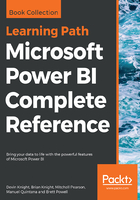
What this book covers
Chapter 1, Getting Started with Importing Data Options, begins by getting the audience oriented with the Power BI Desktop. Next, they will learn how to connect to various common data sources in Power BI. Once a data source is chosen, the options within will be explored, including the choice between data import, direct query, and live connection.
Chapter 2, Data Transformation Strategies, explores the capabilities of the Power Query Editor inside the Power BI Desktop. Using this Power BI Query Editor, the reader will first learn how to do basic transformations, and they will quickly learn more advanced data-cleansing practices. By the end of this chapter, the audience will know how to combine queries, use parameters, and read and write basic M queries.
Chapter 3, Building the Data Model, discusses one of the most critical parts of building a successful Power BI solution—designing an effective data model. In this chapter, readers will learn that while designing a data model, they are really setting themselves up for success when it comes to building reports. Specifically, this chapter will teach the audience how to establish relationships between tables, how to deal with complex relationship designs, and how to implement usability enhancements for the report consumers.
Chapter 4, Leveraging DAX, teaches that the Data Analysis Expression (DAX) language within Power BI is critical to building data models that are valuable to data consumers. While DAX may be intimidating at first, readers will quickly learn that its roots come from the Excel formula engine. This can be helpful at first, but as you find the need to develop more and more complex calculations, readers will learn that having a background in Excel formulas will only take them so far. This chapter will start with an understanding of basic DAX concepts but quickly accelerate into more complex ideas, such as Time Intelligence and Filter Context.
Chapter 5, Visualizing Data, describes how to take a finely tuned data model and build reports that properly deliver a message that clearly and concisely tells a story about the data.
Chapter 6, Using a Cloud Deployment with the Power BI Service, examines deploying your solution to the Power BI Service to share what you've developed with your organization. Once deployed, you can build dashboards, share them with others, and schedule data refreshes. This chapter will cover the essential skills a BI professional would need to know to top off a Power BI solution they have developed.
Chapter 7, Planning Power BI Projects, discusses alternative deployment modes for Power BI, team and project roles, and licensing. Additionally, an example project template and its corresponding planning and dataset design processes are described.
Chapter 8, Connecting to Sources and Transforming Data with M, depicts the data access layer supporting a Power BI dataset, including data sources and fact and dimension table queries. Concepts of the Power Query M language, such as query folding and parameters, are explained and examples of custom M queries involving conditional and dynamic logic are given.
Chapter 9, Designing Import and DirectQuery Data Models, reviews the components of the data model layer and design techniques in support of usability, performance, and other objectives.
Chapter 10, Developing DAX Measures and Security Roles, covers the implementation of analysis expressions reflecting business definitions and common analysis requirements. Primary DAX functions, concepts, and use cases such as date intelligence, row-level security roles, and performance testing are examined.
Chapter 11, Creating and Formatting Power BI Reports, describes a report planning process, data visualization practices, and report design fundamentals, including visual selection and filter scopes. Top report development features, such as slicer visuals, tooltips, and conditional formatting are also reviewed.
Chapter 12, Applying Custom Visuals, Animation, and Analytics, examines powerful interactive and analytical features, including drillthrough report pages, bookmarks, the Analytics pane, ArcGIS Maps, and the waterfall charts. Additionally, examples of custom visuals, such as the Power KPI, and the capabilities of animation to support data storytelling are provided.
Chapter 13, Designing Power BI Dashboards and Architectures, provides guidance on visual selection, layout, and supporting tiles to drive effective dashboards. Alternative multi-dashboard architectures, such as an organizational dashboard architecture, are reviewed, is the configuration of dashboard tiles and mobile-optimized dashboards.
Chapter 14, Managing Application Workspaces and Content, features the role and administration of app workspaces in the context of Power BI solutions and staged deployments. Additionally, the Power BI REST API, content management features, and practices are reviewed, including field descriptions and version history.
Chapter 15, Managing the On-Premises Data Gateway, covers top gateway planning considerations, including alternative gateway architectures, workloads, and hardware requirements. Gateway administration processes and tools are described, such as the manage gateways portal, gateway log files, and PowerShell Gateway commands.
Chapter 16, Deploying the Power BI Report Server, contrasts the Power BI Report Server with the Power BI cloud service and provides guidance on deployment topics such as licensing, reference topology, configuration, administration, and upgrade cycles.
Chapter 17, Creating Power BI Apps and Content Distribution, walks through the process of publishing and updating apps for groups of users. Additionally, other common distribution methods are covered, such as the sharing of reports and dashboards, email subscriptions, data-alert-driven emails, and embedding Power BI content in SharePoint Online.
Chapter 18, Administering Power BI for an Organization, highlights data governance for self-service and corporate BI, Azure Active Directory features such as Conditional Access Policies, and the Power BI admin portal. Details are provided about configuring Power BI service tenant settings, managing Power BI Premium capacities, and the tools available to monitor Power BI activities.
Chapter 19, Scaling with Premium and Analysis Services, reviews the capabilities of Power BI Premium and alternative methods for allocating premium capacity. Additionally, Power BI datasets are contrasted with Analysis Services models, Azure Analysis Services is contrasted with SQL Server Analysis Services, and the migration of a Power BI dataset to an Analysis Services model is described.